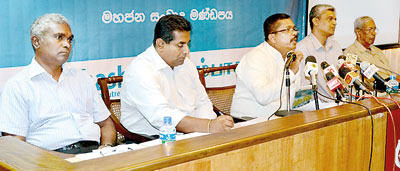News
Separate power generation accounts will show where CEB costs rise, says expert
View(s):The Ceylon Electricity Board should institute transparency in decision-making and set up separate cost accounts available for public scrutiny, an expert in the power sector urged this week. Dr. Thilak Siyambalapitiya, an independent advisor on electricity generation and external lecturer at the University of Moratuwa made the call at a panel discussion organised last Tuesday by the Organisation of Professional Associations (OPA).

The panel discussion underway on Tuesday. Pic by Hasitha Kulasekera
“Transparency is important. We are told that there is an increase in the production cost but as a consumer I would be interested in knowing what prompted the cost increase,” Dr. Siyambalapitiya said. The average generation cost per unit of electricity in 2013 was Rs.15.74, according to the Public Utilities Commission (PUC). The cost of transmission, distribution and the loss of electricity at generation should be added to this, Dr. Siyambalapitiya said.
He called for the establishment of a separate account in the pricing structure which would show payments for the cost of generators. This information should be open to the public, and weekly updates of the account would be necessary.
He also suggested that stricter administrative supervision would increase the efficiency of distribution units, pointing out that CEB did not maintain separate accounts for these units that would show if they incurred profits or losses. The Executive Director of the Sri Lanka Energy Forum, Ashoka Abeygunawardena, told the meeting that the existing pricing formula was precise and the CEB did not need to introduce a new system derived using “grade 6 Mathematics”.
The CEB had proposed increased prices to cover increased production cost of Rs.256 billion for 2013, and this sum could be achieved using the existing formula according to which consumers who use fewer units of electricity will have to pay less while those who consume more units will have to pay more.
This, he said, also “encouraged conservation”. He stressed a hike of only 2 per cent was required and that the CEB was trying to deceive the public by claiming that an increase of 60 per cent was necessary. “I can prove that the increased production cost is only Rs. 2 billion and not Rs. 82 billion,” he said.
The Executive Director of Lawyers for Human Rights Development, Kalyananda Thiranagama, said he believed the proposed price hike did not reflect actual costs. He said providing concessions for large-scale consumers was unnecessary because these commercial consumers unlike domestic users, earned revenue with the electricity used to facilitate production.
“According to the CEB, domestic consumers – who use fewer units – have to (subsidise) large-scale factories using over 227,702 units of electricity per month,” he said. The Secretary of the Lanka Electricity Workers Association, Ranjan Jayalal, accused the CEB management of waste and misuse of office property.
“What is the rationale behind charging extra fees from the public to cover up losses incurred due to inefficient administration?” he questioned. “Last year, for the Deyata Kirula Exhibition, a cardboard construction costing Rs.4.1 million was made. I was told that the construction would be used afterwards but when I visited the site after the exhibition all I could see were ruins of the structures. The Rs. 4.1 million rupees incurred was a loss,” he said.
Follow @timesonlinelk
comments powered by Disqus














